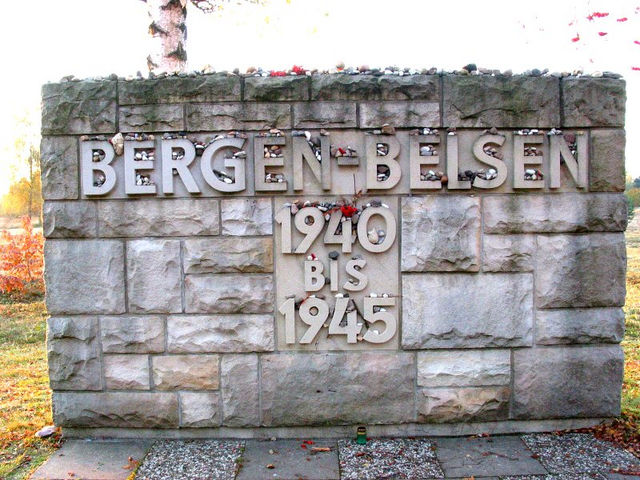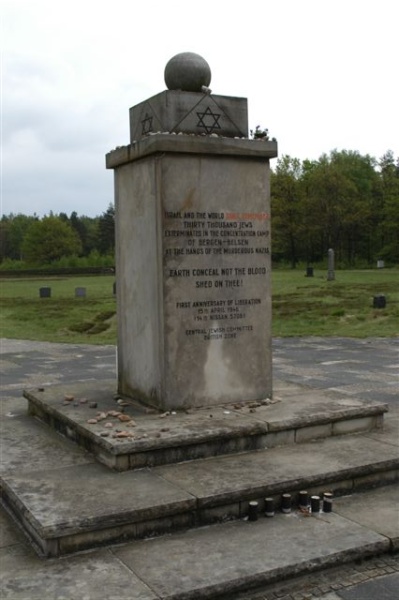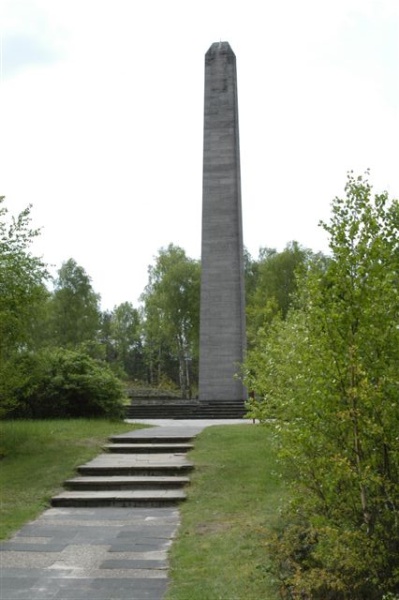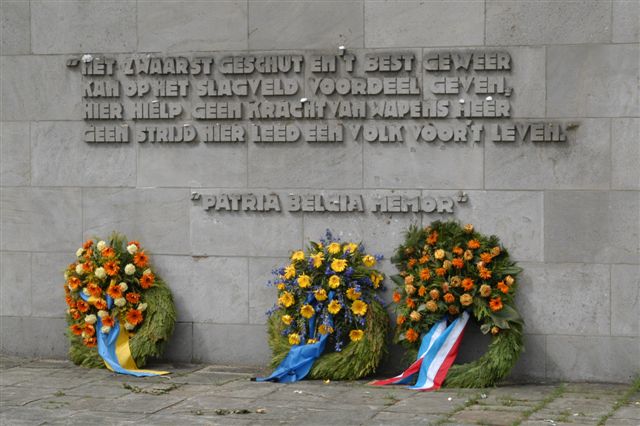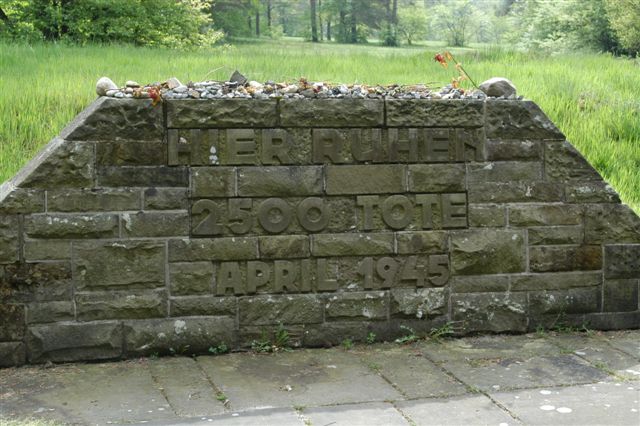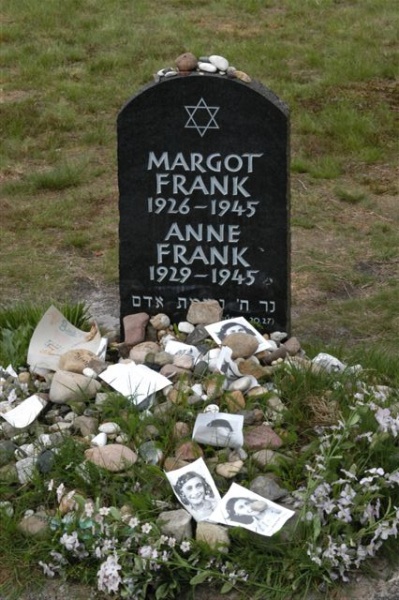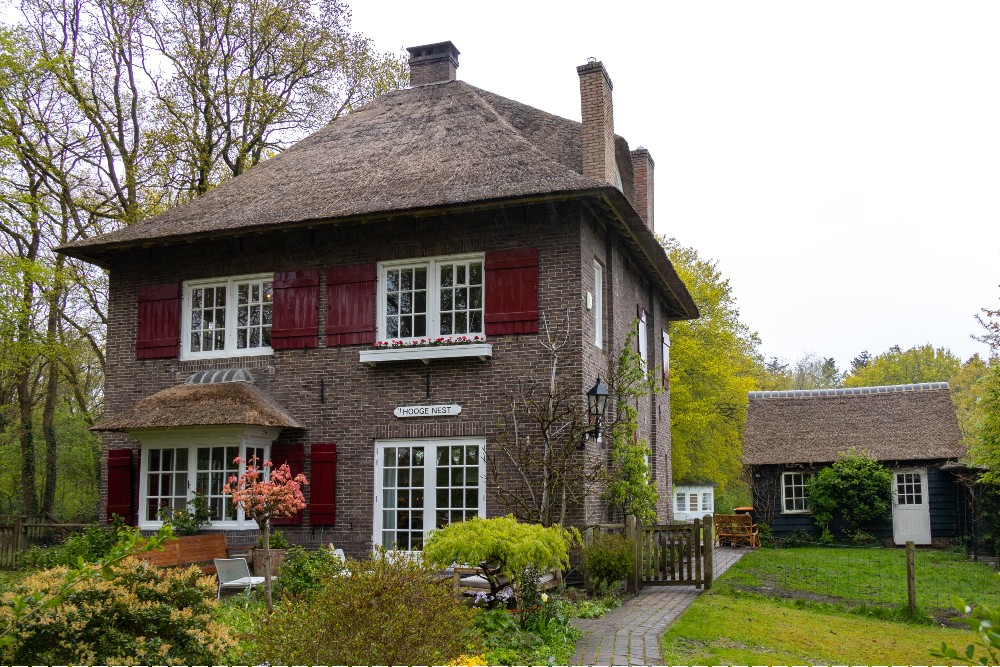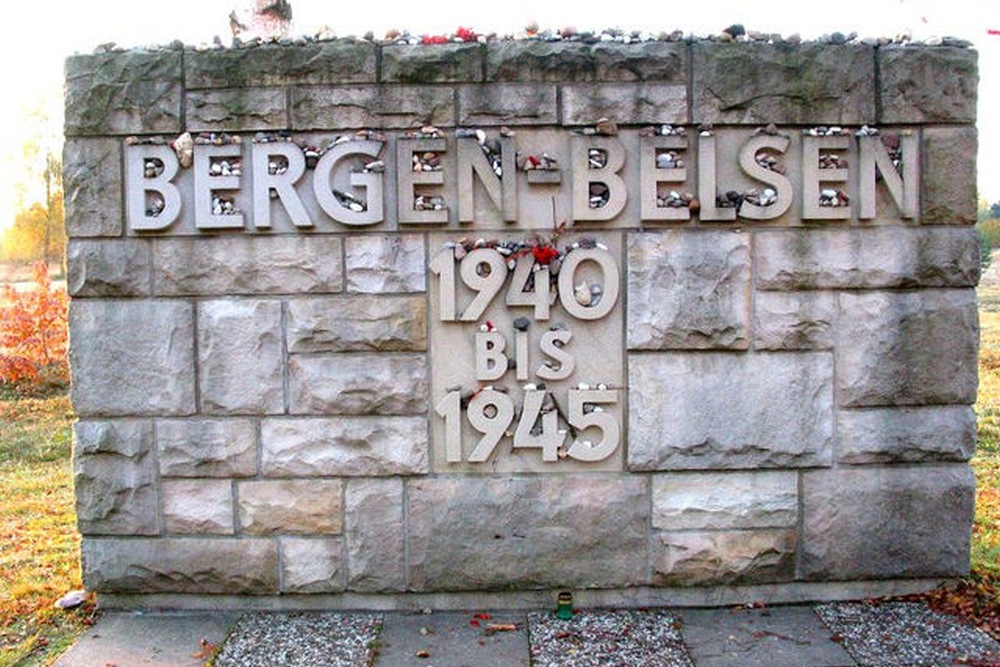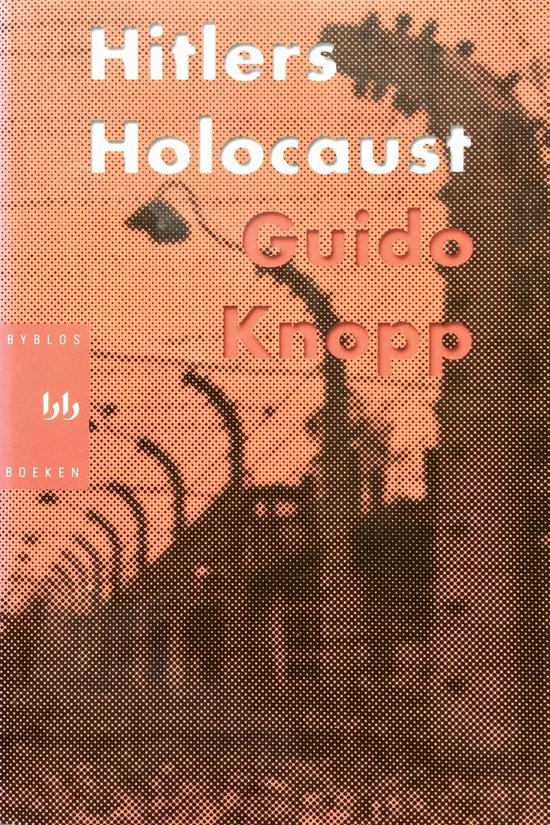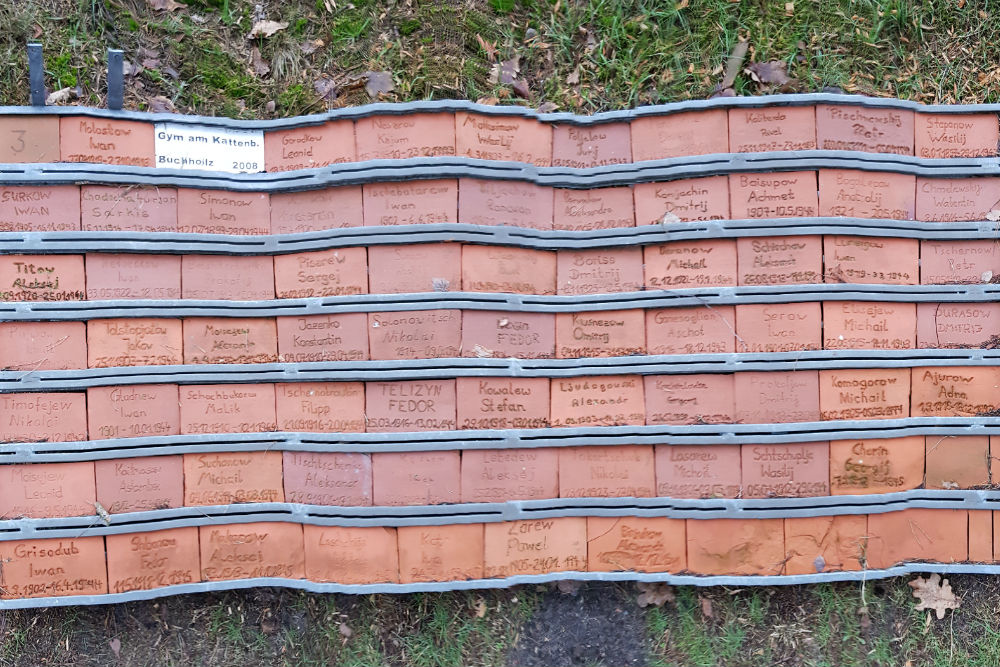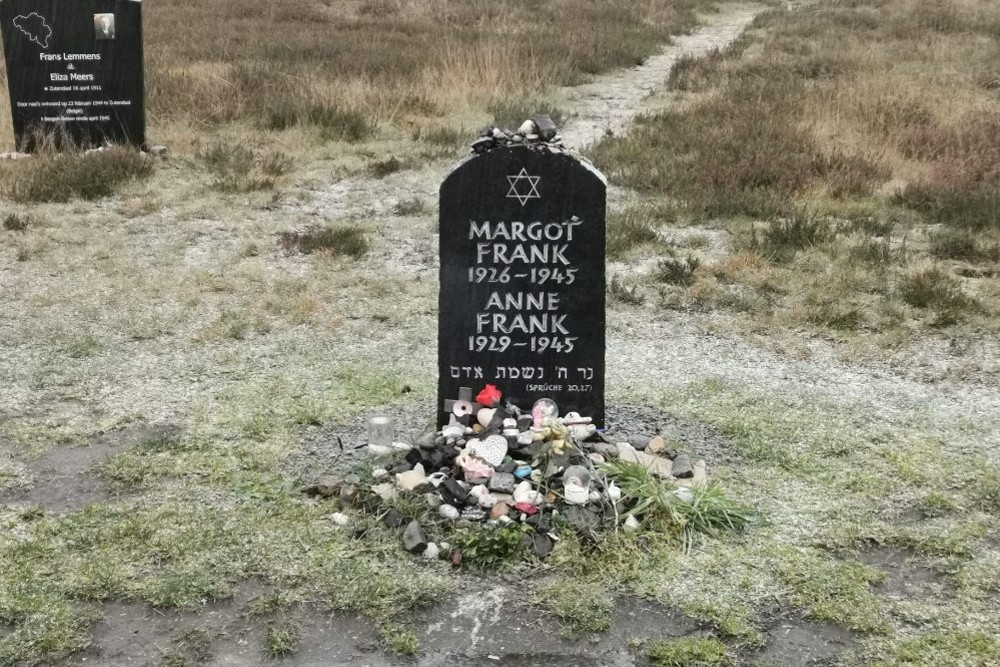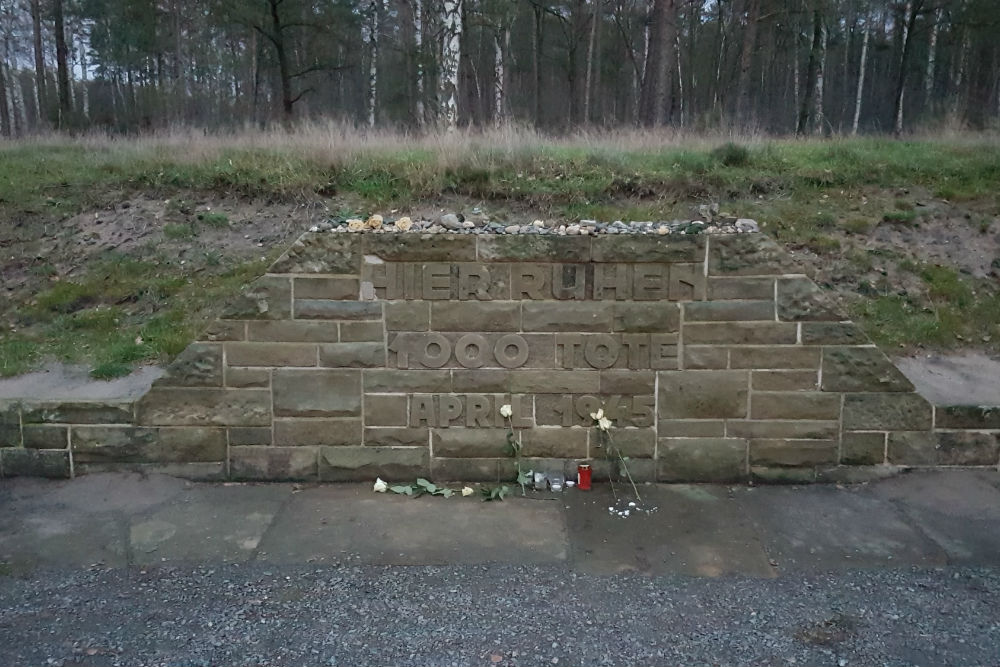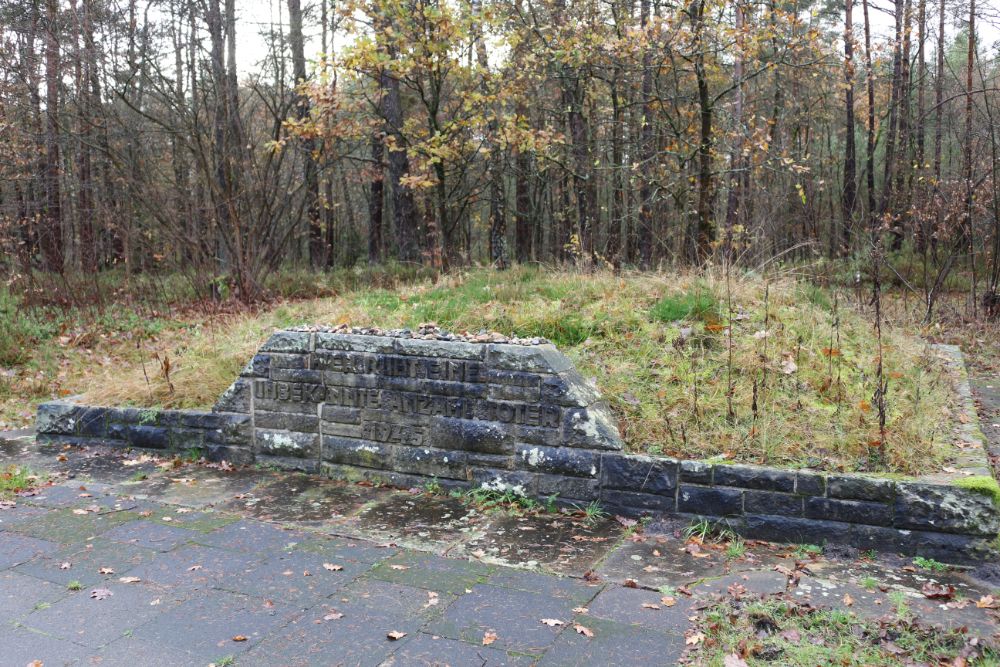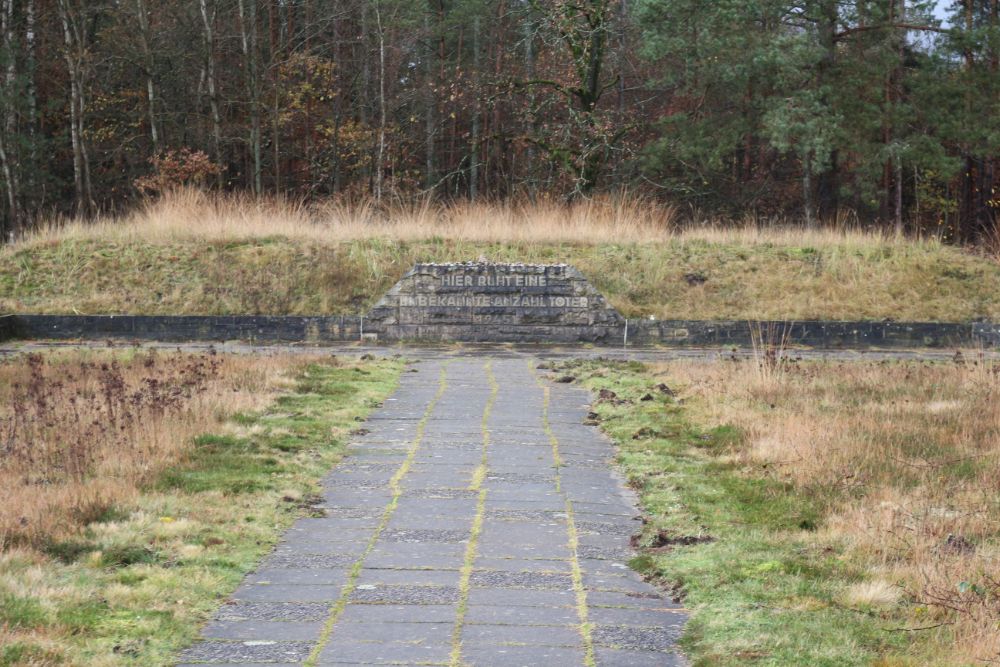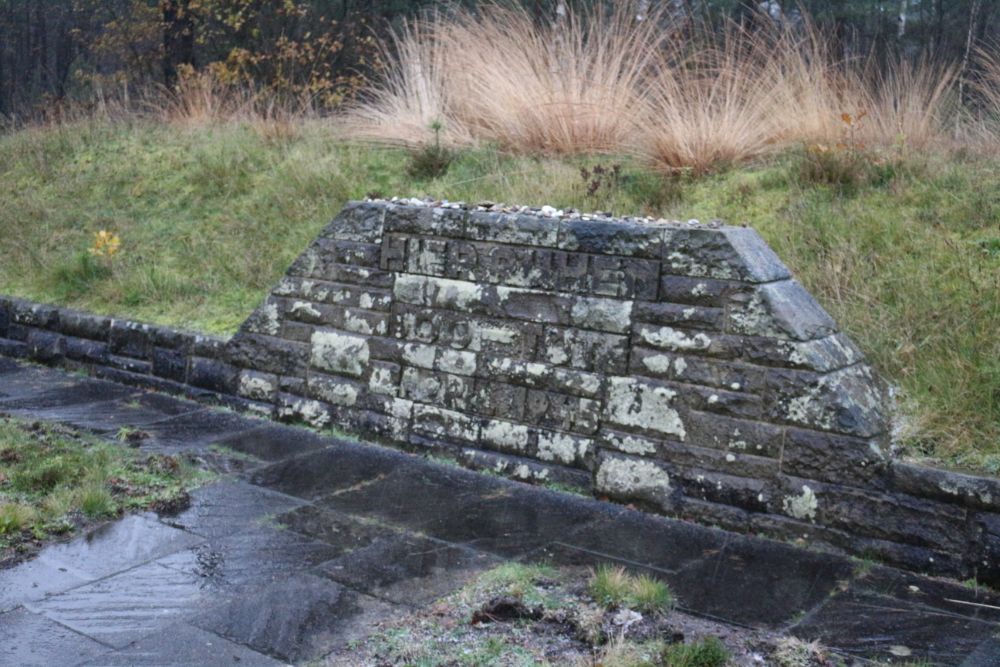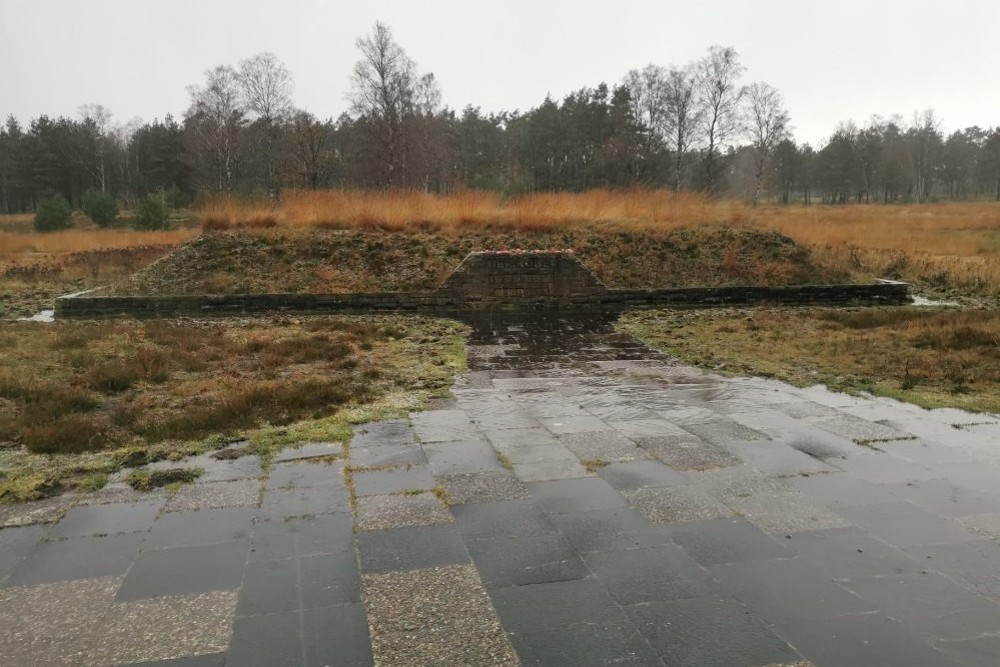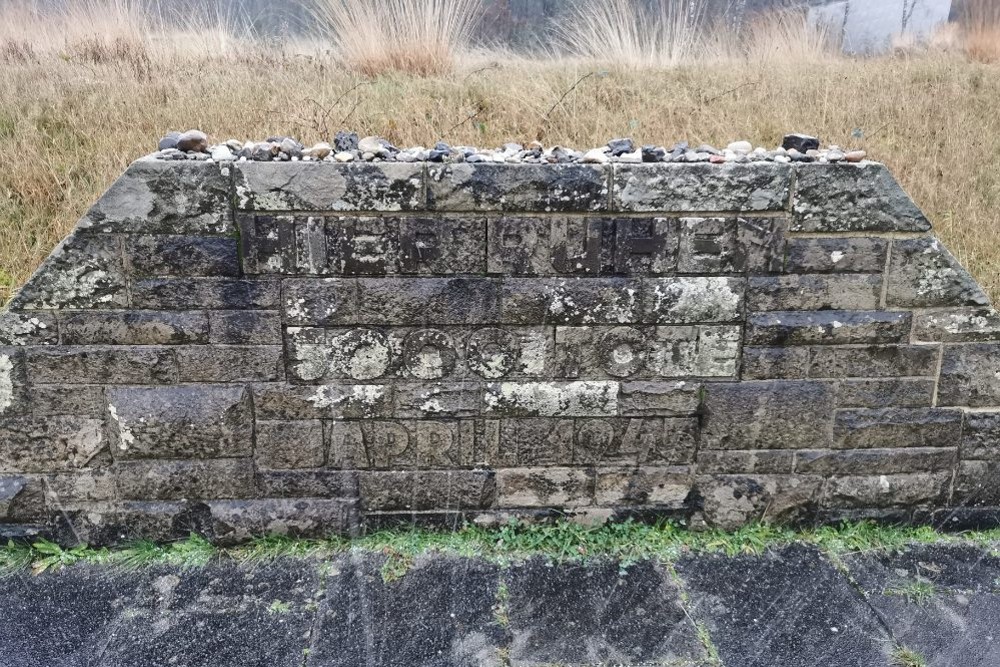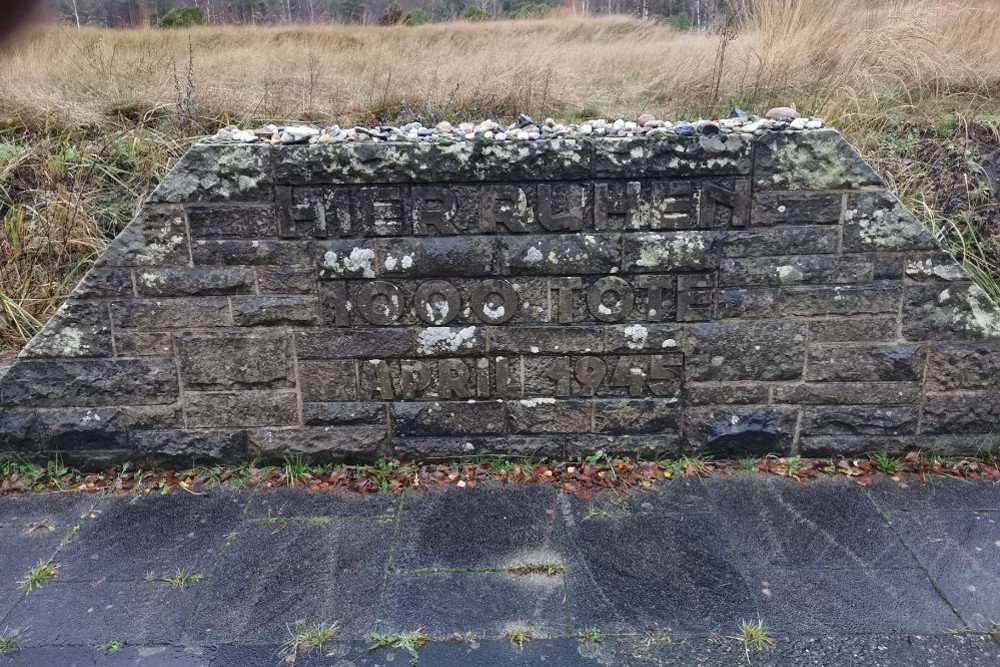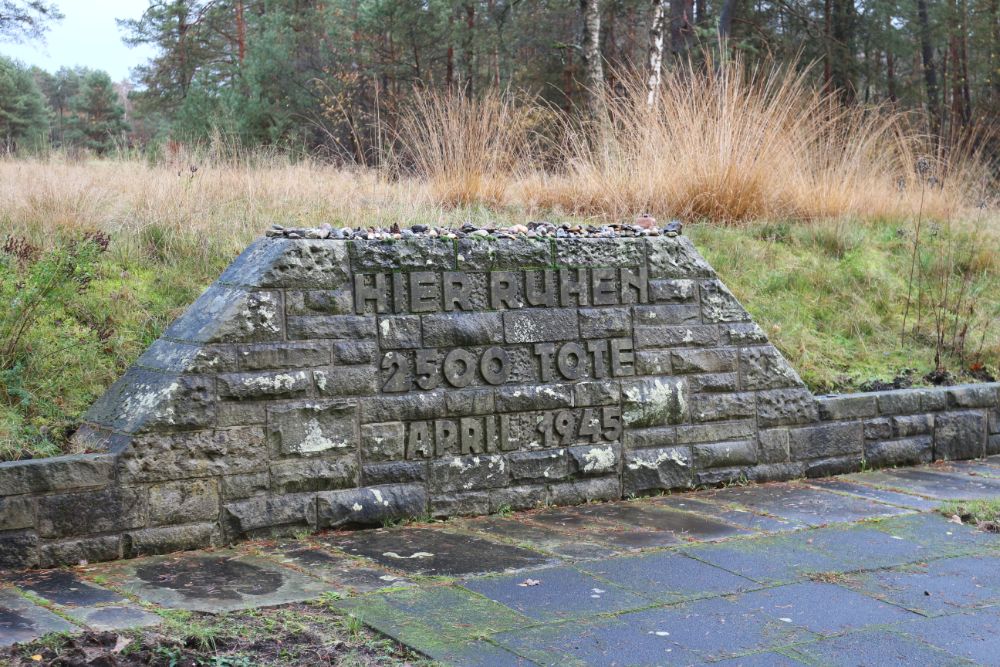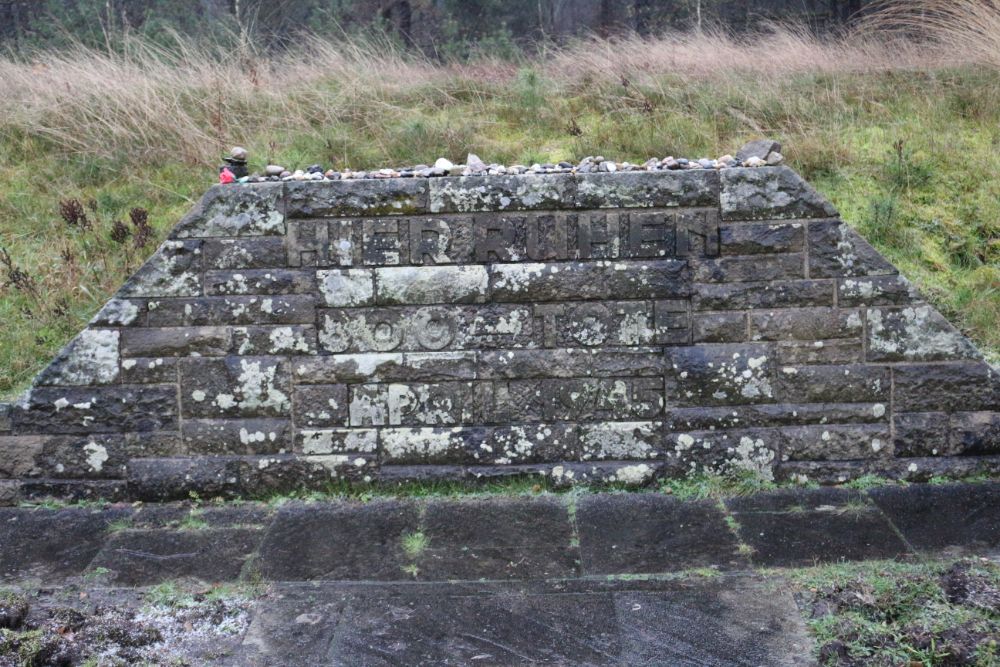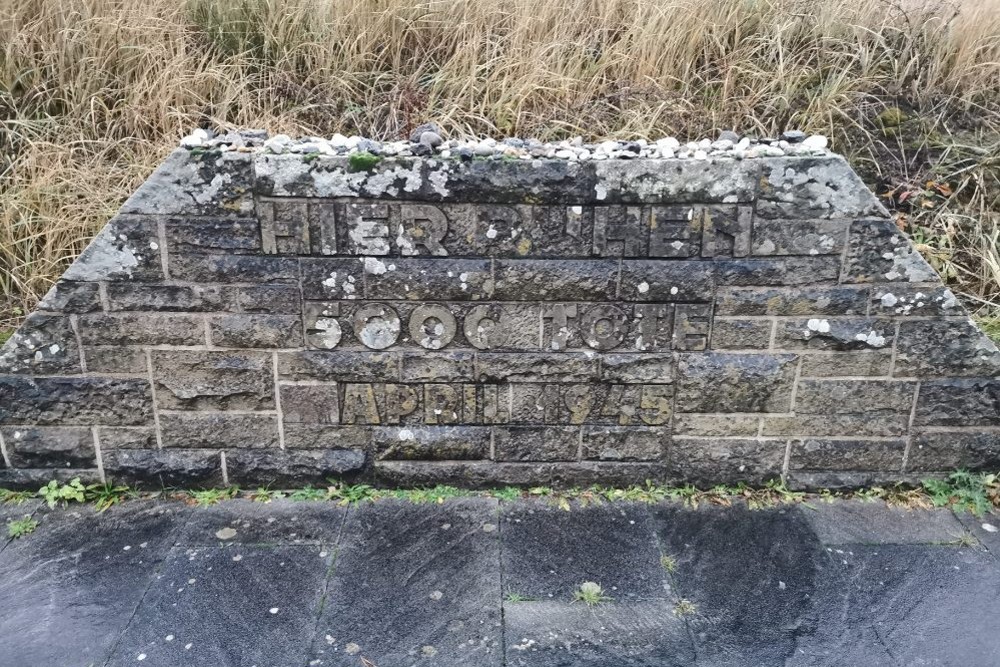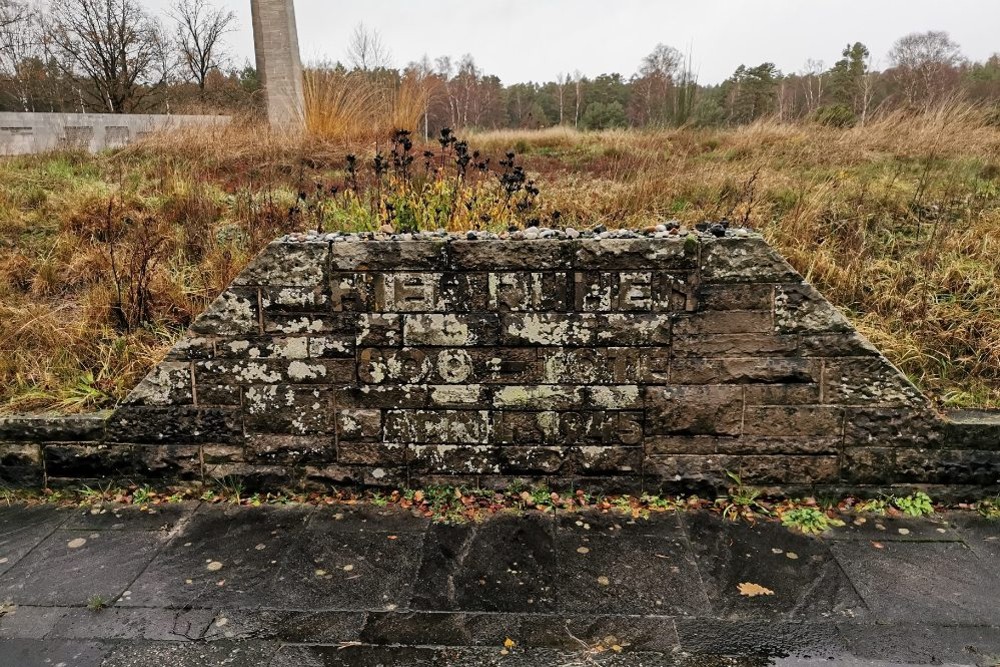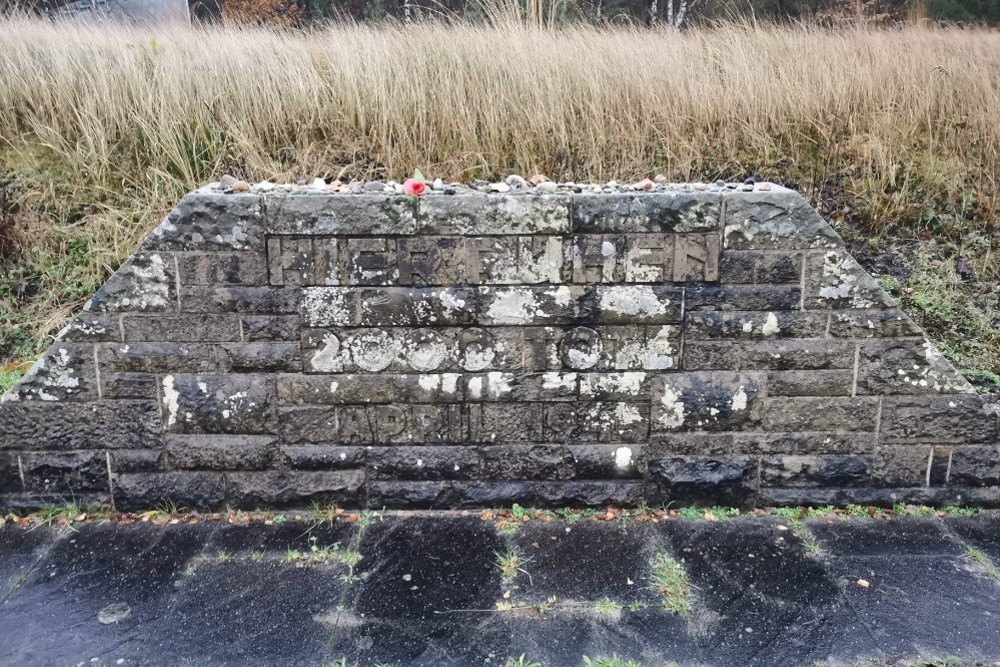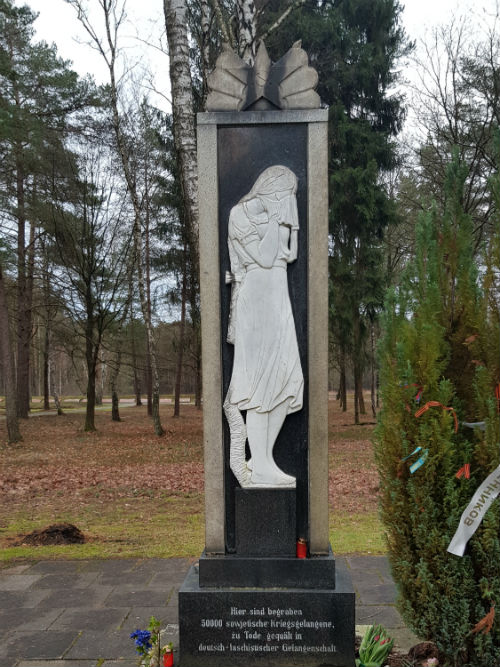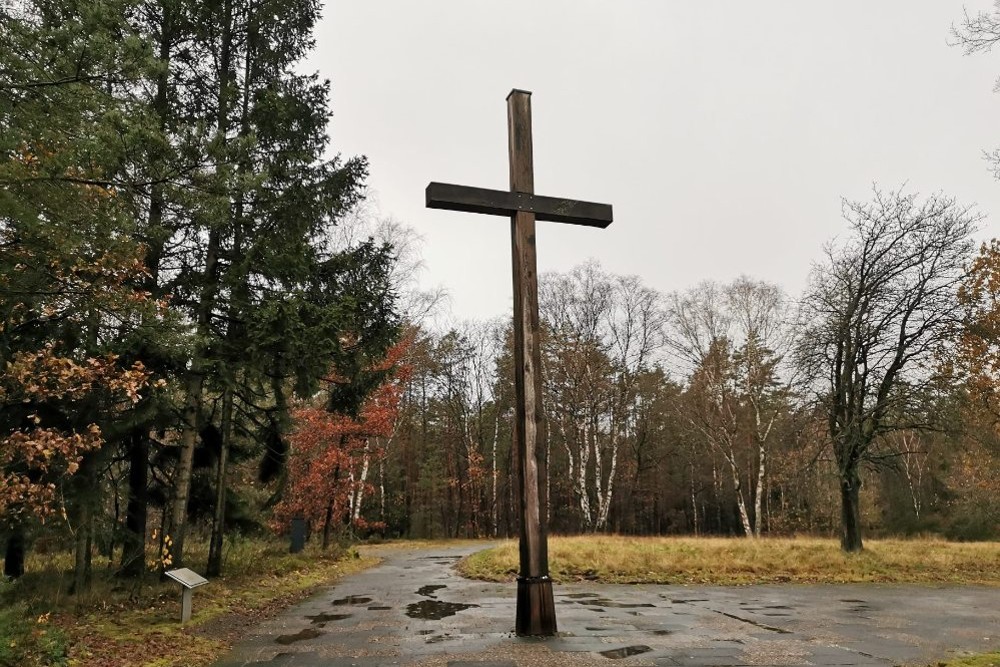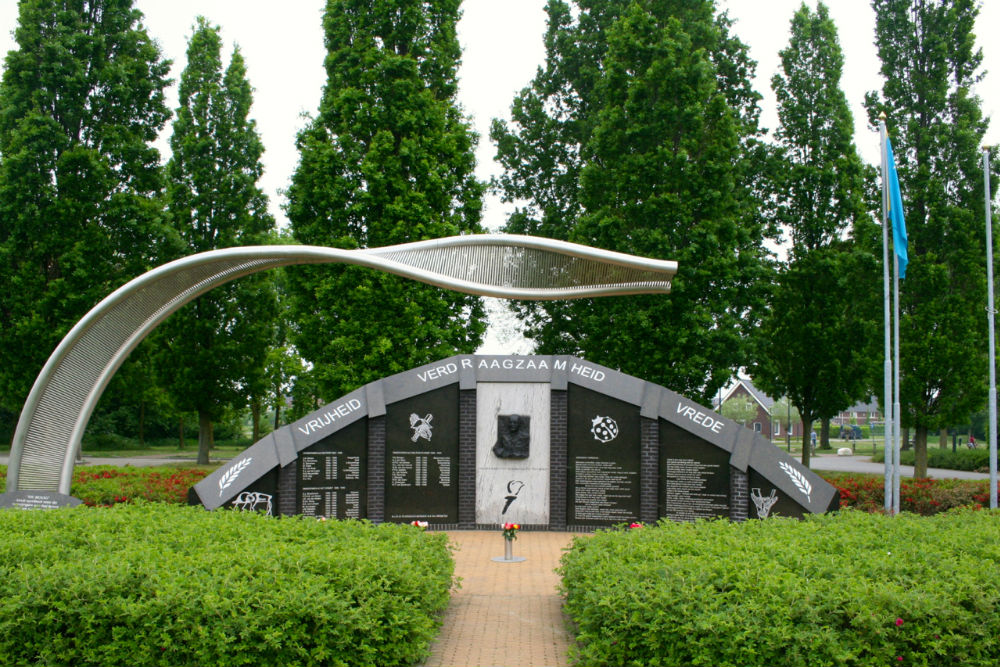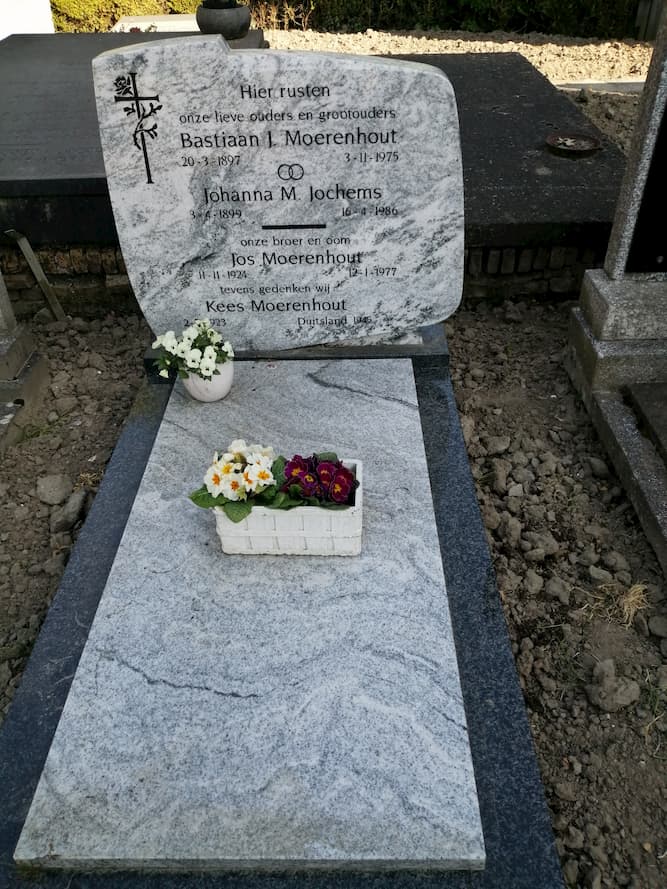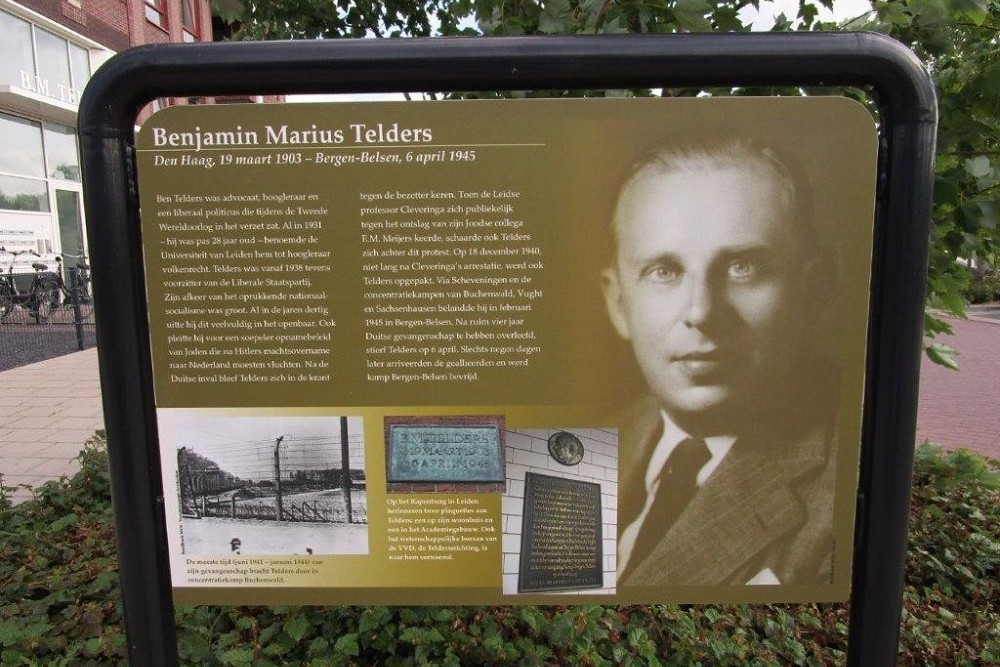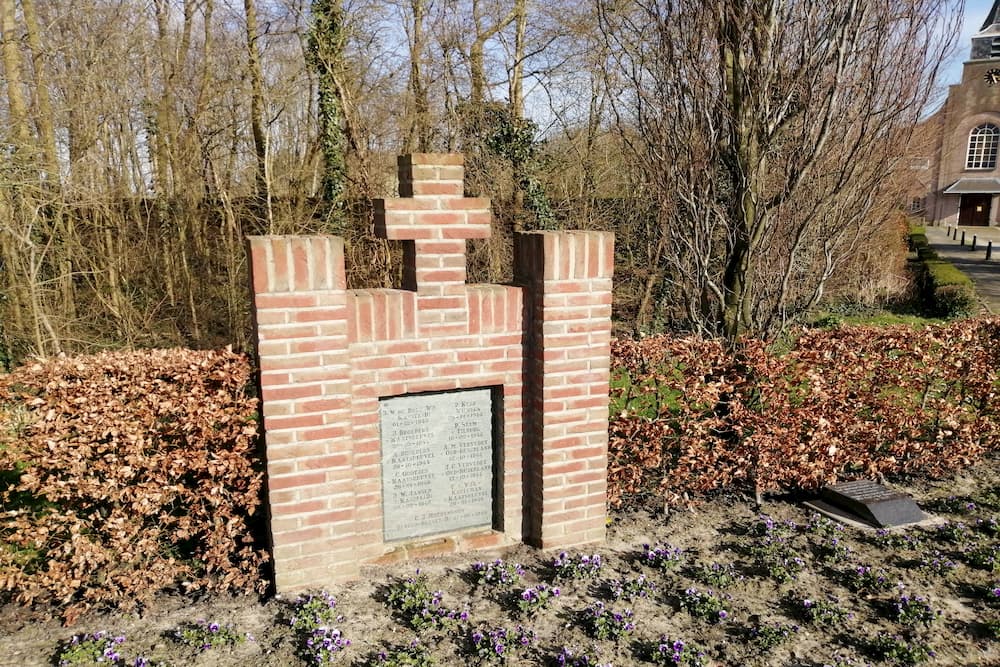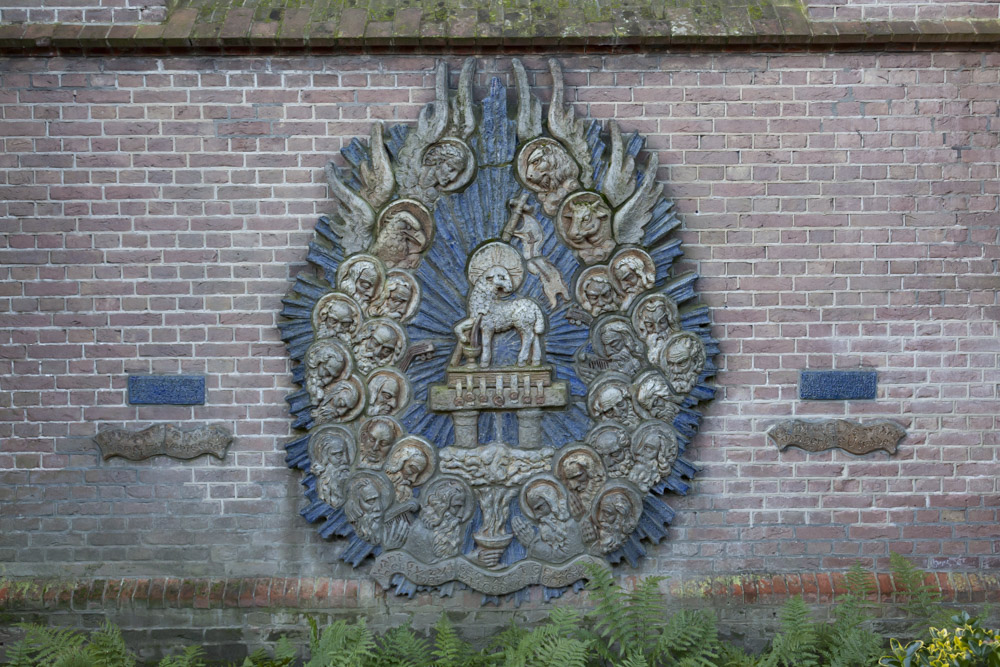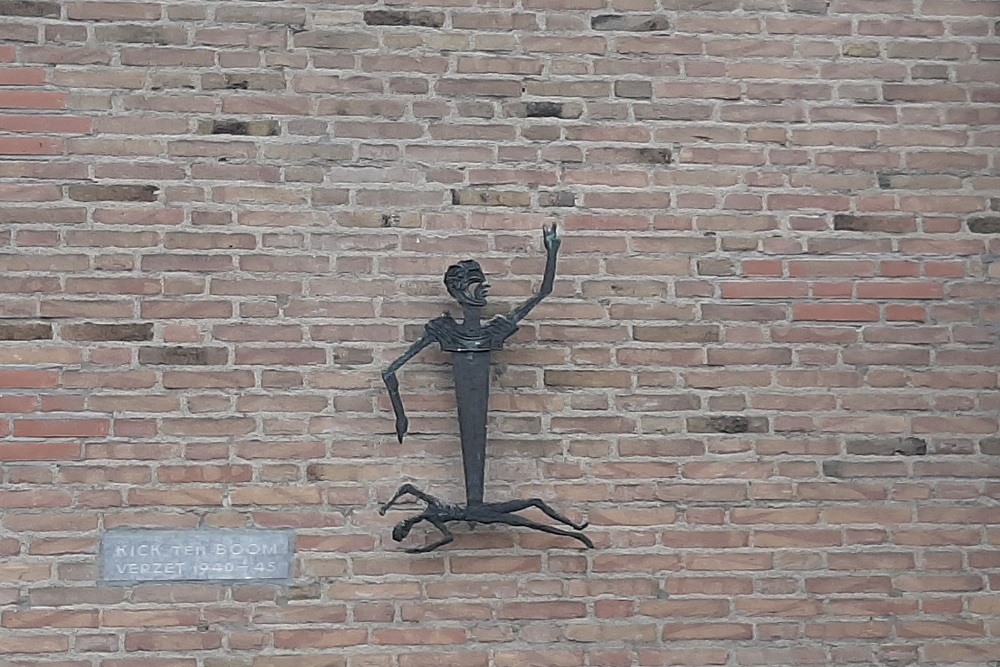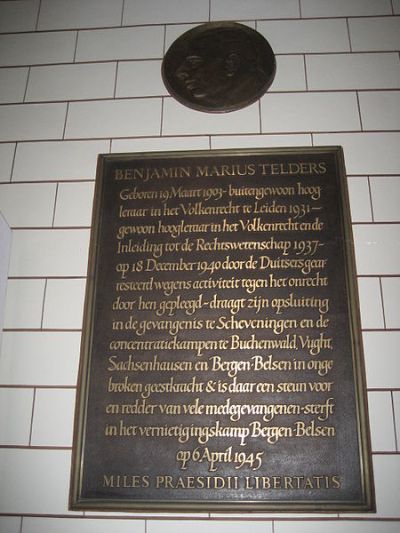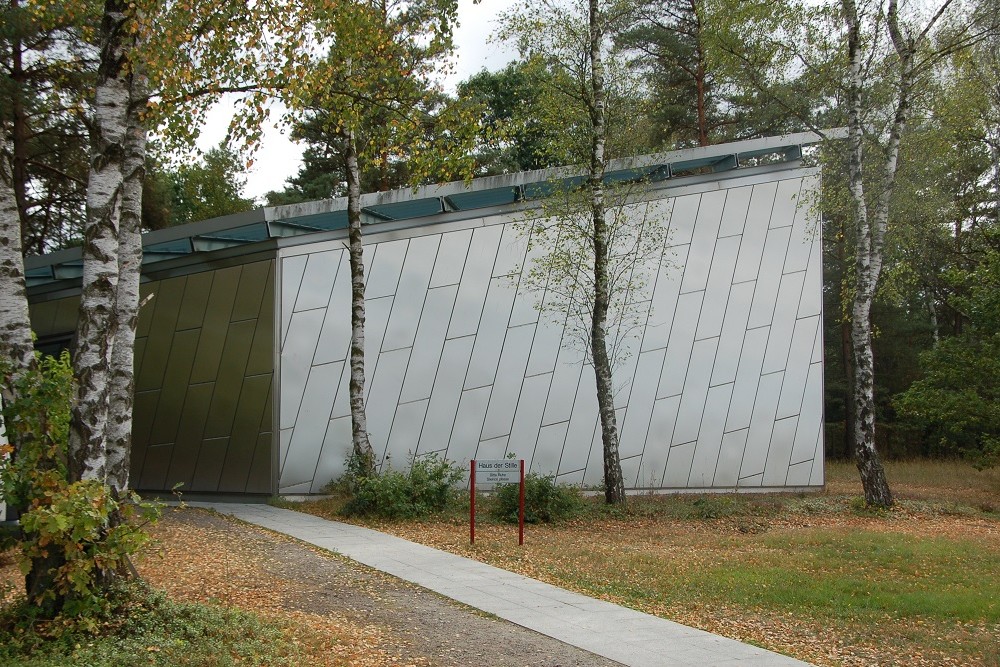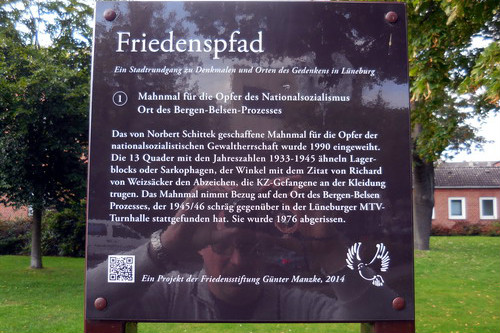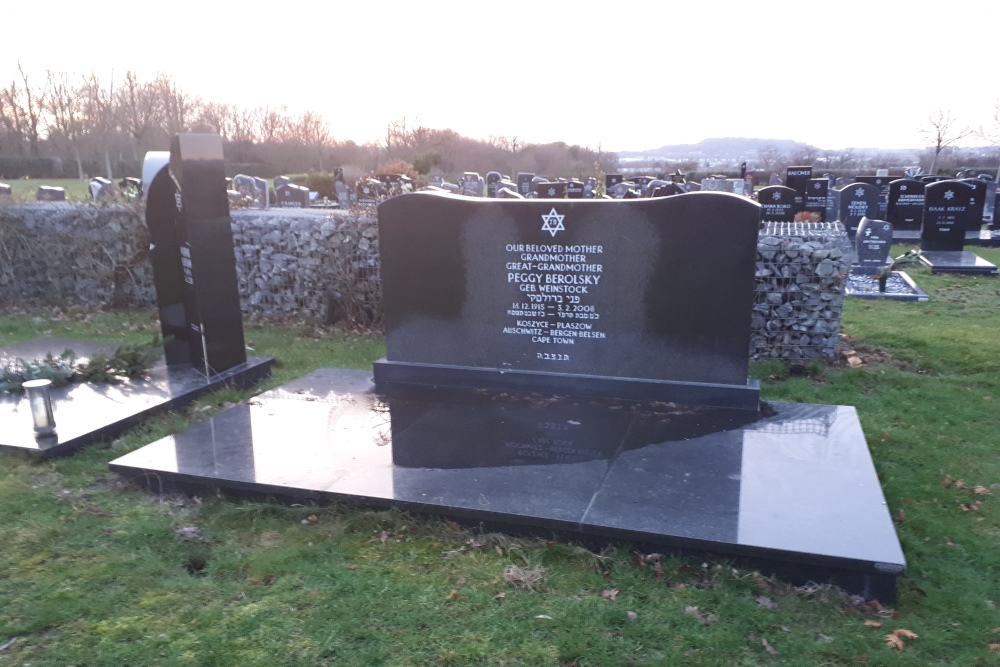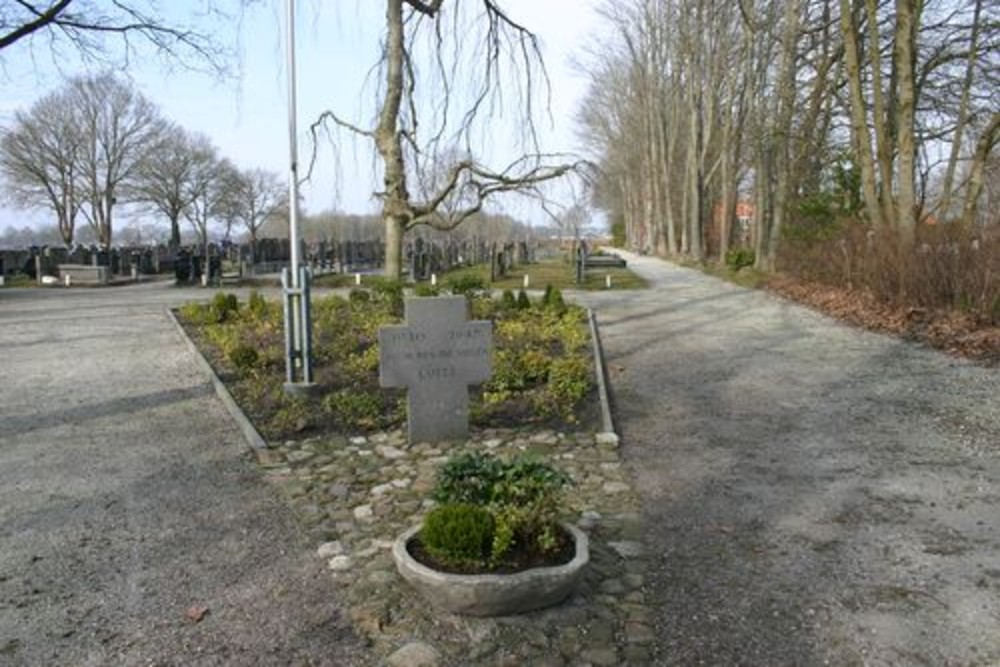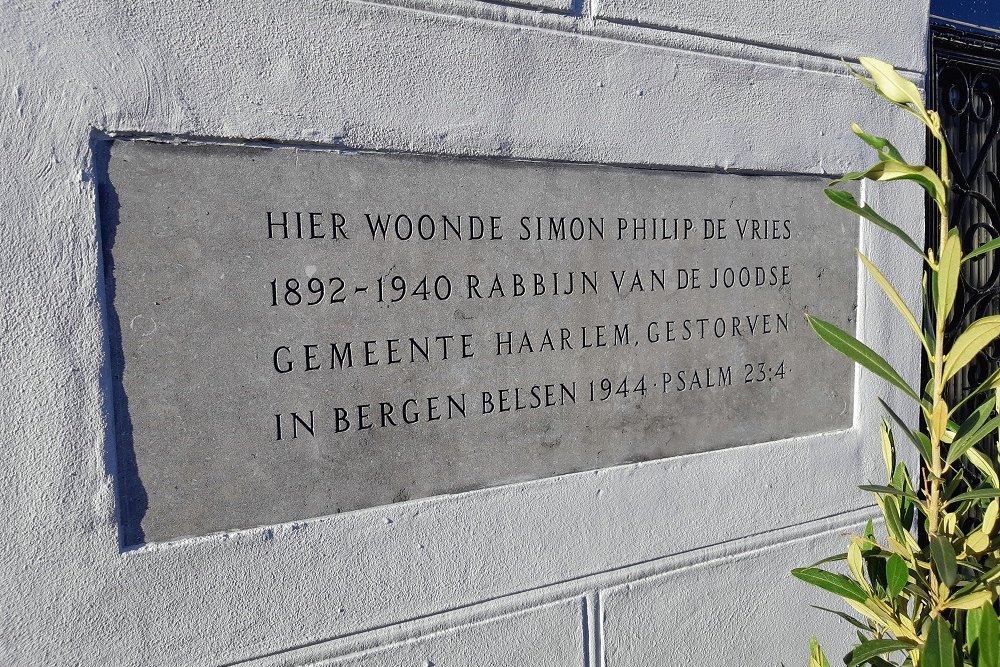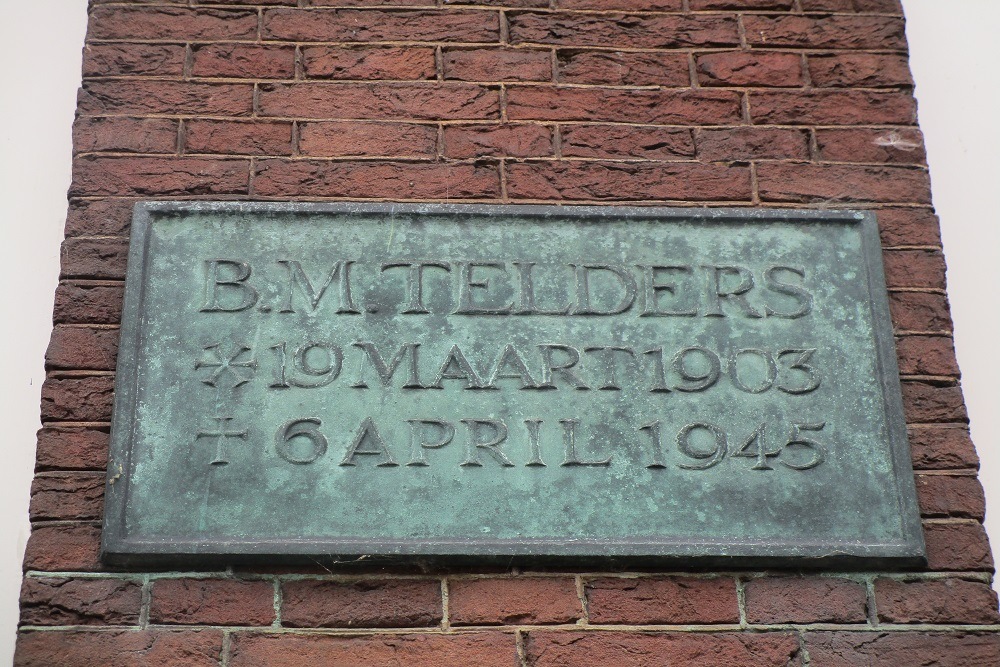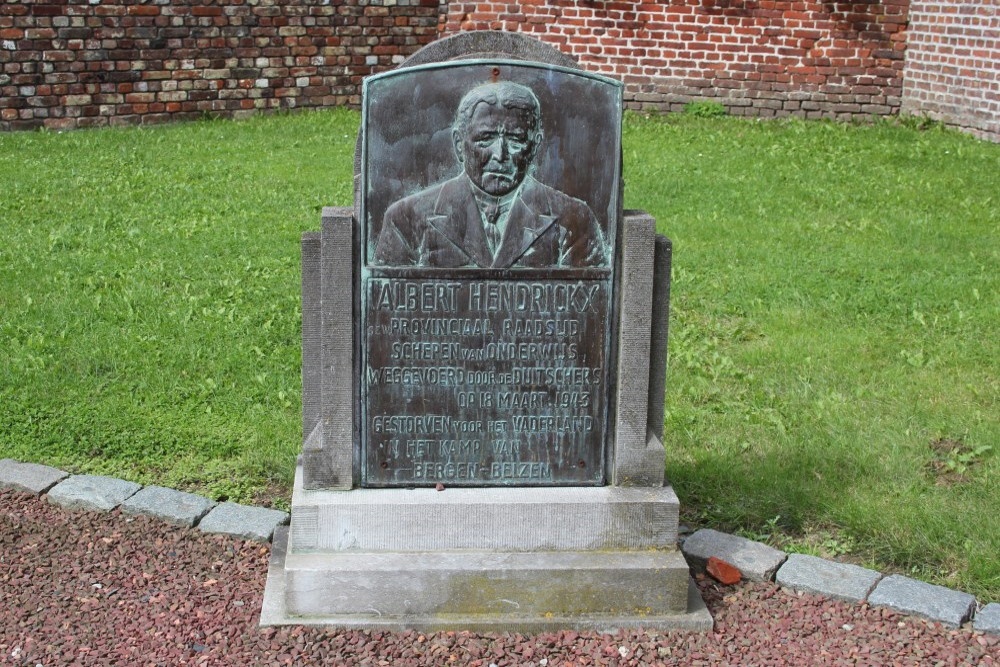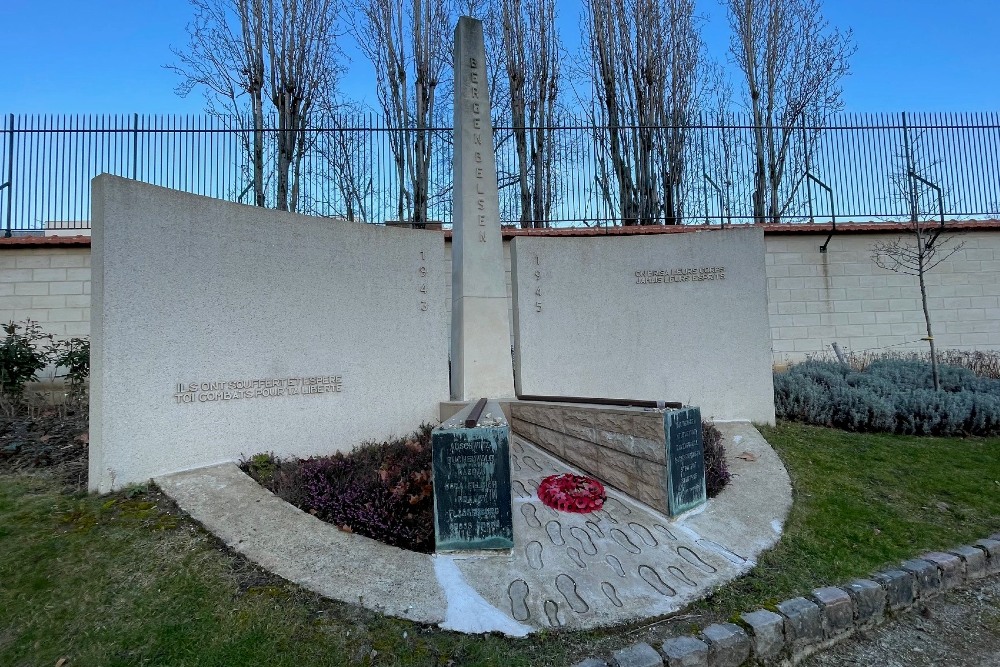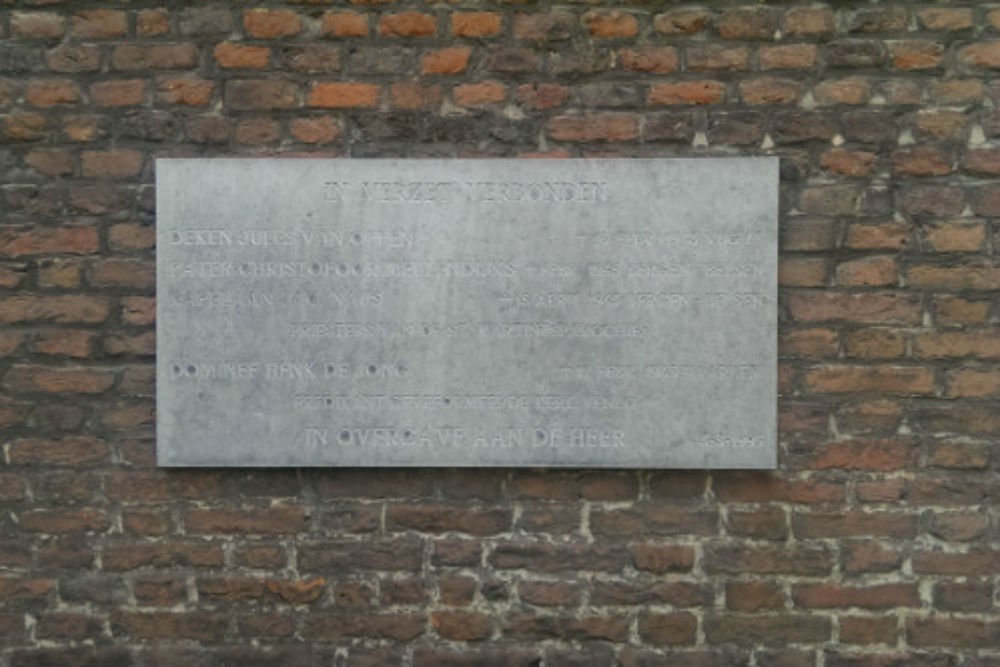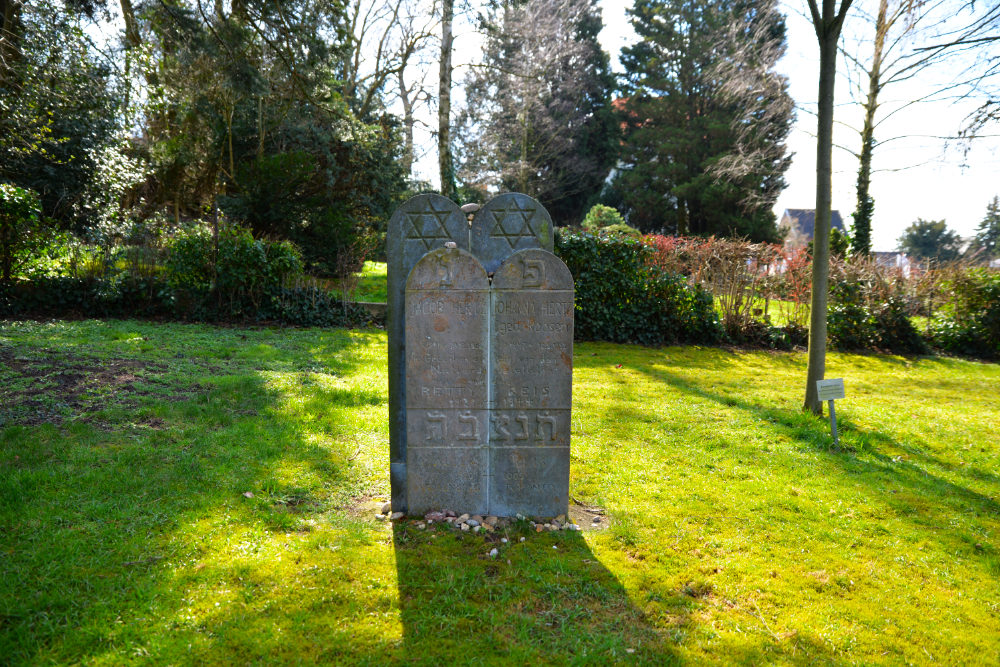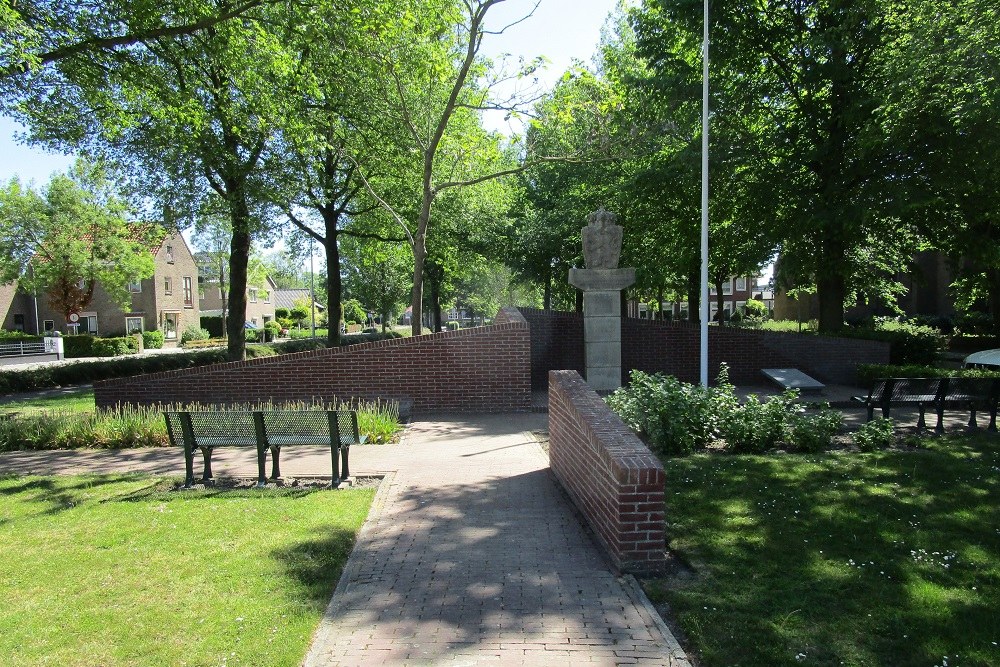Previous history
Bergen-Belsen was liberated by the British troops on 15 April 1945. It was not the first camp to be liberated, but it was most likely the most infamous camp at that time. The gruesome scenes of Bergen-Belsen which were captured by British army photographers, soon went round the world and pictured the cruel Nazi regime. These pictures finally revealed the true nature of the concentration camps to the world. Bergen-Belsen would soon serve as an example of Nazi camps. But this is not entirely in keeping with the truth.
The town Bergen-Belsen does in fact not exist. Belsen is a small village, while Bergen was a larger town with 13,000 residents. Both are located about sixty kilometres northeast of Hannover. In 1935 the German Wehrmacht built a barracks with practice ground between both locations. It was a modern barracks for the Panzertruppenschule with well-equipped sleeping-places, canteens, kitchens, etc. To provide housing for the workers who were building the barracks, a camp with approximately thirty barracks was built.
During the May days of 1940, the former practice ground was used as a prisoner-of-war camp, where about 600 Belgian and French soldiers were accommodated. A year later it received its first official name Stalag 311 (XI C). A few weeks after the start of operation Barbarossa, the German attack on the Soviet Union, the first prisoner transports arrived at Bergen-Belsen. By July 1941, around 21,000 Russian prisoners of war were locked up in Bergen-Belsen. Their living conditions were miserable: in open air surrounded by barbed wire, without any sanitary provisions. By February 1942, more than 18,000 prisoners had died. Many died as a consequence of dysentery, but especially the typhoid epidemic of November 1941 caused most victims to die. At the same time, hundreds of Soviet commissioners were deported to Sachenhausen to be executed in concordance with Hitler’s guidelines.
The SS took over command of Bergen-Belsen in April 1943.
Definitielijst
- May days
- The five days of combat of the Dutch army against the German invasion during World War 2 for 10-15 May 1940.
- Nazi
- Abbreviation of a national socialist.
- Soviet Union
- Soviet Russia, alternative name for the USSR.
- Wehrmacht
- German armed military forces, divided in ground forces, air force and navy.
Images
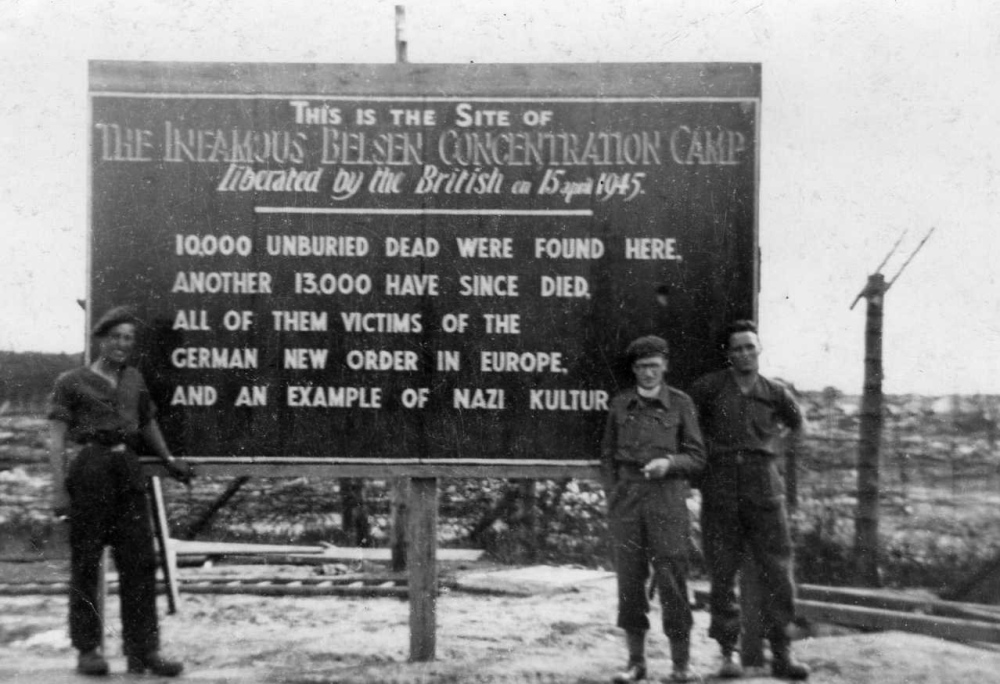 Sign placed by the Allies after the liberation of camp Bergen-Belsen. The man on the right is the British engineer Tom Turner of the 59 Mechanical Equipment Platoon R.E., which dug the mass graves for the dead prisoners after the liberation of the camp. Source: Alan Turner.
Sign placed by the Allies after the liberation of camp Bergen-Belsen. The man on the right is the British engineer Tom Turner of the 59 Mechanical Equipment Platoon R.E., which dug the mass graves for the dead prisoners after the liberation of the camp. Source: Alan Turner. The Wehrmachtkazerne at Bergen-Belsen (1), the prisoners of war camp (2), the prisoners of war hospital (3). Source: Gedenkstätte Bergen-Belsen.
The Wehrmachtkazerne at Bergen-Belsen (1), the prisoners of war camp (2), the prisoners of war hospital (3). Source: Gedenkstätte Bergen-Belsen.Bergen-Belsen 1943 - 1944
The SS had different intentions with the camp. Reichsführer-SS Heinrich Himmler had adopted a plan from the Ministry of Foreign Affairs, which argued that Germans who were incarcerated abroad would be exchanged for Jews. The guidelines of the Reichssicherheitshauptamt (RSHA) of 31 August 1943 made clear who would be eligible for detention in this camp: "1. Juden, die verwandtschaftliche oder sonstige Beziehungen zu einflußreichen Personen im feindlichen Ausland haben; 2. Juden, die unter Zugrundelegung eines günstigen Schlüssels für einen Austausch gegen im feindlichen Ausland internierte oder gefangene Reichsangehörige in Frage kommen; 3. Juden, die als Geiseln und als politische oder wirtschaftliche Druckmittel brauchbar sein können; 4. Jüdische Spitzenfunktionäre." So therefore only Jewish top officials, Jews with important connections abroad or those with a British or American passport, with a passport from one of the neutral countries (such as Sweden, Spain) or with a Palestine certificate (authorization to immigrate to Palestine) could be accommodated here. From now on, Bergen-Belsen was a Zivilinternierungslager. But when it became clear that camps with such a designation could be inspected by the Red Cross or international committees, the official name was changed into "Aufenthaltslager Bergen-Belsen" in June 1943.
Part of the camp was still being used by the Wehrmacht, mainly as military hospital. To prepare the camp for the arrival of thousands of Jews, 500 prisoners from Natzweiler and Buchenwald were transported to Bergen-Belsen. Here they were part of the Aufbaukommando that had to extend the camp. They were also responsible for the improvement of the sanitary provisions. A small crematorium was also built. In July 1943 the first Jewish prisoners arrived at the camp. But the prisoners were not put up all together: there were separate compartments. These compartments were separated from each other by barbed wire fences, making contact between the different compartments impossible.
There was the ordinary prisoners’ camp, including the Aufbaukommando. Because most prisoners had died due to the terrible living conditions, this commando was shut down in February 1944. From now on, many weakened prisoners, who were not capable of performing labour, were sent to this camp section from other camps. Bergen-Belsen was considered an "unproductive" camp (there was no general work duty) by the SS-Wirtschafts- und Verwaltungshauptamt (SS-WVHA) so it seemed a good idea to send those that were no longer "economically useful" to this section. But those that ended up in this section of the camp were subjected however to a form of work duty. Officially Bergen-Belsen was never a concentration camp, but this Häftlingslager [prisoner camp] was managed as such: the prisoners wore striped outfits and were being tortured and abused by the Kapos. On 27 March 1944 the first transport arrived: 1,000 prisoners from the underground V1-weapon factory in Nordhausen.
There was also the Sternlager, with 4,000 Jews eligible for exchange (so-called Austauschjuden). A mixed group of men and women were accommodated here. They could keep their civilian clothes, but wearing the Star of David was obligatory. In the Sternlager the largest group was made up of Dutch prisoners from camp Westerbork. Life was evidently better here: families could stay together and they did not have to work. Shmuel Huppert, who stayed with his mother as Austauschjude in Bergen-Belsen, later recalled: "From a certain point of view, life was quite reasonable. Reasonable in the sense that we received three blankets so that we wouldn’t be cold and that we had some food. It was not much, but we could survive. We didn’t work. I learned how to play chess in Bergen-Belsen and I still play chess. But the most important thing was that we were together, that I was never separated from my mother."
In the Neutralenlager several hundreds of Jews from neutral countries were accommodated. Here too the living conditions were bearable; the prisoners were not assigned to the work commands and usually there was enough food. The section was governed by a Jewish council chaired by a Jewish chairman.
Polish Jews with Latin-American passports or Palestine certificates were put up in the Sonderlager. They were separated from the other prisoners, because they could report about the SS crimes in the east. Most of them were eventually deported to Auschwitz.
In July 1944 the Hungarian camp was established. In it were 1,683 Hungarian Jews that Himmler wanted to exchange for money and goods. This group also had its own management, was not part of the work groups and did not have to take part in roll calls.
In early August 1944, a Sternlager was set up in the open terrain behind the encampment where thousands of women were accommodated. Initially the women transports mainly came from Poland (Warsaw). Later thousands of women arrived from Auschwitz and Birkenau. Amongst them was Anne Frank, who would not survive the camp. After a violent autumn storm had destroyed most tents in November 1944, the women were put up in newly built barracks. Most women would however not stay very long in Bergen-Belsen. The SS sent them to other places to work. They mostly ended up in the satellite camps Buchenwald and Flossenbürg.
| Date: | Camp section: | Definition: | 1944 | Häftlingslager I | Section where prisoners from other camps who were too weak to work would be accommodated. |
| Sternlager | Section where the so-called Austauschjuden – the Jews eligible for exchange – would stay. | |
| Neutralenlager | Here the Jews from neutral countries were put up. | |
| Sonderlager | tdSection for Polish Jews with Latin-American passports or Palestine certificates. | |
| Ungarnlager | Established in July 1944 for Hungarian Jews that Himmler wanted to exchange for money and goods. | |
| Zeltlager | Established in August 1944 to receive the increasing number of transports of women from Poland and Auschwitz | |
| Kriegsgefangenenlazarett | Originally established to accommodate severely ill patients. Discontinued in January 1945 and replaced with a large Frauenlager [women’s camp]. | |
| 1945 | Häftlingslager II | Because Häftlingslager I was becoming too small, as of 1945 part of the Sternlager was used to receive the large stream of prisoners. |
Definitielijst
- concentration camp
- Closed camp where people are being held captive that are considered to be anti- social, enemies of the state, criminal or unwanted individuals. These groups mostly do not get a fair trial or are condemned to doing time in a camp.
- Jews
- Middle Eastern people with own religion that lived in Palestine. They distinguished themselves by their strong monotheism and the strict observance of the Law and tradition. During World War 2 the Jewish people were ruthlessly persecuted and annihilated by the German Nazis. . An estimated 6,000,000 Jews were exterminated.
- RSHA
- Reichssicherheitshauptamt. The central information and security service of the Third Reich.
- Wehrmacht
- German armed military forces, divided in ground forces, air force and navy.
Images
 A map of Bergen-Belsen with an indication of where the different camp units are located. Source: Gedenkstätte Bergen-Belsen.
A map of Bergen-Belsen with an indication of where the different camp units are located. Source: Gedenkstätte Bergen-Belsen.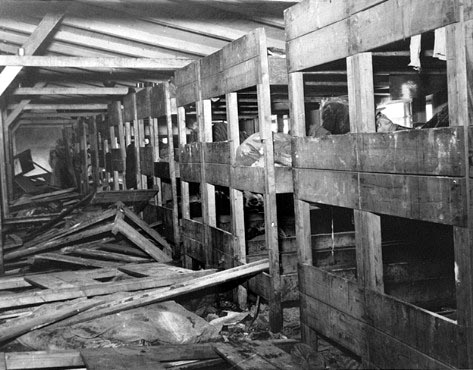 The barracks and the many bunk beds which accommodated tens of people. Source: Scrapbookpages.
The barracks and the many bunk beds which accommodated tens of people. Source: Scrapbookpages.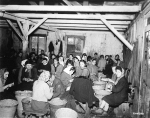 When there was still food: women are peeling potatoes in their barrack. Source: Scrapbookpages.
When there was still food: women are peeling potatoes in their barrack. Source: Scrapbookpages.Bergen-Belsen: 1944 - 1945
With the appointment of Josef Kramer as camp commander, the transition to an ordinary concentration camp was completed, although that was never confirmed officially by a name change. At that time, approx. 15,000 prisoners were locked up here. With the arrival of Kramer the hell of Bergen-Belsen truly began. It’s due to this hellish period that the camp "thanks" its reputation. The appointment of Kramer to camp commander – together with the abolishment of the privileges for the Austauschjuden and the flood of new prisoners – was the start of what later would be called the "hell of Bergen-Belsen".
At the West front the Americans and British advanced further, while at the same time the march of the Soviets in the East could not be stopped. Despite this, the SS did not set free the KZ-prisoners. The threatened camps were evacuated by means of the infamous dead marches. Tens of thousands of people were sent on their way by foot. For many of them Bergen-Belsen was the final destination. The number of people in the camp quickly rose and was no longer in proportion to the capacity of the camp. At the beginning of January 1945, 15,000 prisoners were housed in Belsen. At the end of the month the number had risen to 22,000. Late February 41,000 and 60,000 when the camp was liberated. In this period more than 35,000 people died.
Only a few of them died as a consequence of cruelties by the guards. It was also not necessary to gas or execute prisoners. Anita Lasker Walfisch, who ended up in Bergen-Belsen after Auschwitz, explained: "In Auschwitz people were murdered; in Bergen-Belsen they would just let them die." The circumstances in the camp were terrible. The main cause of death was mainly lack of food and epidemics. The guards made no effort to improve the living conditions. Many barracks were not completed. Those that were fully built, quickly fell apart. Because of the overpopulation there were hardly any wooden beds. There were no sanitary provisions at all: no heating, no water tabs, no toilets… The prisoners were only given a minimum of food: two slices of bread and half a litre water soup a day. As the war progressed, in many parts of the camp no food was supplied at all. Supposedly two hundred cases of cannibalism took place.
Because of the lack of sanitary provisions and streaming water, the already weakened prisoners in the crowded camp were prone to diseases. The many rodents and bodies that the small crematorium could not process, were a feeding ground for diseases such as (spot)typhoid, tuberculosis, dysentery and cholera. Most prisoners suffered from digestive disorders and couldn’t control their bowel movements. Those who could not stand up anymore, relieved themselves on their wooden beds. In February 1945, the worst epidemic broke out. Typhoid killed thousands of people in the last months before the liberation. The camp was littered with piles of bodies.
In April 1945, another 7,000 Austauschjuden from Bergen-Belsen were transported to Theresienstadt, but soon their place was taken by thousands of new prisoners from Nordhausen. To improve the lack of space by any means possible, the nearby Wehrmacht barracks was seized. But this initiative proved just a drop in the ocean.
In the last days before the liberation, the SS tried to do something about the ever growing piles of bodies. Kramer ordered two thousand prisoners to drag the bodies in the streets of the camp to mass graves – huge open pits. For hours at a time, forced by whips from the SSers and the Kapos, the tired prisoners dragged thousands of bodies. It is estimated that 17,000 bodies were thrown into those open or shallow pits. At the background the prisoners’ band played dance music, 'to improve the atmosphere’, according to Kramer’s ordinance.
Definitielijst
- concentration camp
- Closed camp where people are being held captive that are considered to be anti- social, enemies of the state, criminal or unwanted individuals. These groups mostly do not get a fair trial or are condemned to doing time in a camp.
- Theresienstadt
- City in the Czech Republic. Here the Nazis established a model concentration camp.
- Wehrmacht
- German armed military forces, divided in ground forces, air force and navy.
Images
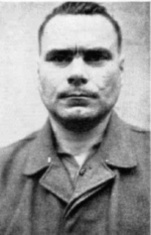 Josef Kramer, the new camp commander of Bergen-Belsen. Source: Scrapbookpages.
Josef Kramer, the new camp commander of Bergen-Belsen. Source: Scrapbookpages.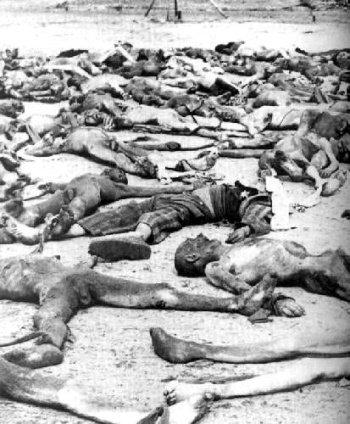 Due to the arrival of many new prisoners from other camps, the living conditions in Belsen worsened dramatically, resulting in many thousands of deaths. Source: Scrapbookpages.
Due to the arrival of many new prisoners from other camps, the living conditions in Belsen worsened dramatically, resulting in many thousands of deaths. Source: Scrapbookpages.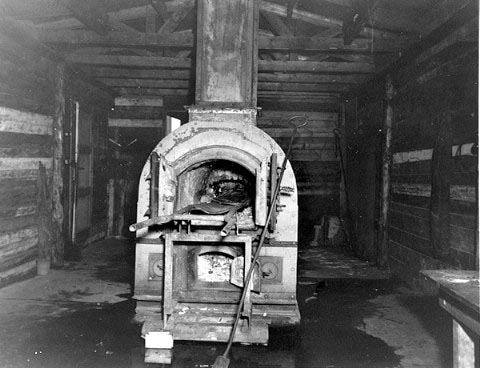 This small crematorium in Belsen could not process the many dead, so most bodies were just not processed. Source: Scrapbookpages.
This small crematorium in Belsen could not process the many dead, so most bodies were just not processed. Source: Scrapbookpages.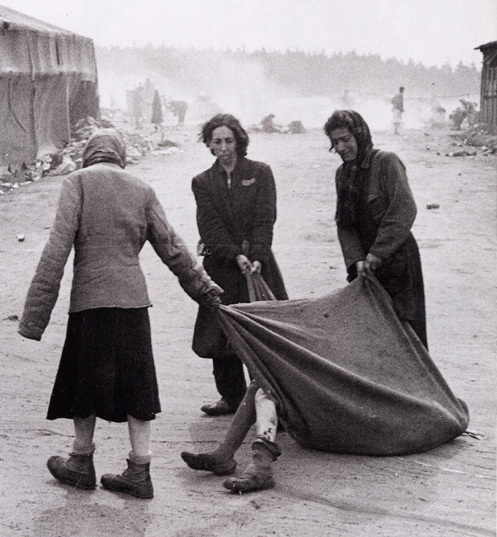 In the days preceding the liberation, the prisoners were ordered to drag the many bodies to mass graves. Source: Scrapbookpages.
In the days preceding the liberation, the prisoners were ordered to drag the many bodies to mass graves. Source: Scrapbookpages.The liberation
The end of Bergen-Belsen is a bizarre chapter in the history of the Second World War.
On 11 April 1945, Himmler gave his recently appointed Reich under Commissioner of the camps, SS-Standartenführer Kurt Becher, permission to transfer Bergen-Belsen to the British. One day later, two German officers, Colonel Hanns Schmidt and lieutenant-colonel Bohnekamp reached the allied borders to announce the surrender of the camp. Avoiding fights on the camp site was crucial to avoid the spreading of the typhoid epidemic amongst the fighting parties.The talks led to a local cease-fire. An area of around 48 square metres was declared neutral territory.The Germans would place warning signs with "Danger – Typhoid" on all access roads to the camp and transfer the Wehrmacht barrack to the British. 800 German and 1500 Hungarian soldiers were stationed in this barrack. They stayed put to avoid an outbreak of the epidemic. In the coming days, the Hungarians would serve the British, while the Germans were sent back to their own lines. Most SS guards, who were considered prisoners of war, took off on 13 April.
At first, the British did not really realise what they had stumbled upon. Initially they thought that it was just an "ordinary" internment camp. They were much more interested in the Wehrmacht barrack. In the afternoon of Sunday 15 April, a group of British officers, led by lieutenant-colonel Robert Daniell, commander of the 13th Regiment Royal Horse Artillery, entered the camp. They were awaited by camp commander Kramer and a small group of SSers. It was only after they visited the camp themselves, when they became aware of the true horrific nature of the camp. The British locked up Kramer in an underground basement beneath the officers’ accommodation. Here he had to sleep on the bare floor with no blankets. Additionally 25 female SS camp guards and 28 male SSers were imprisoned. On 18 April, Kramer was transferred to the prisoner-of-war camp at Celle.
Captain William Roach described the camp as follows: "There was no sound or sign of life. The prisoners didn’t even smile. They just stood there and gazed at us. And most of us, just gazed back at them." Often, people imagine that freeing a concentration camp was a joyful occasion. But the truth is clearly different, as was evident from this testimony, explained Zdenka Ehrlich. Together with 300 women she occupied a barrack in Bergen-Belsen. Here place was in the back of the barrack, so she could not see the camp site. Someone said: "Are they here yet?" "Who?", asked someone else. "The English." "Oh," said Zdenka.' That was her reaction. Such indifferent reactions were common for the starved and exhausted prisoners. Many of them hardly realised that they had been liberated.
The prisoners that had any strength left in them, slowly started to realise that their suffering was over and sought contact with the British liberators. They begged for water and food. Russian and Polish prisoners took it upon themselves and broke into SS rooms to search for food. This meant that they finally could have a warm meal again, albeit between thousands of bodies that had not yet been buried.
The situation in Bergen-Belsen was so severe that lieutenant-colonel Richard Taylor, who had been given the task to take over the camp, had to call in the help of other units. He sent a liaison-officer to the headquarters of the VIII Army Corps asking them to urgently send water, food and other aid. The N° 76 Field Hygiene Section was the first to respond to the call for help and helped to improve the hygienic circumstances in the camp. One day after the discovery of the camp the first vehicles with food and water arrived. And the day after that, 27 more water tanks arrived. When the British discovered a stream in the area they built a water pipe with materials found in the camp to one of the water reservoirs. Other units, including the 11th Light Field Ambulance, took care of medical provisions. They tried to take care of the sick and disinfect them. A field hospital was set up in the Wehrmacht barrack which was close by. Here the severely sick were put up. Even German doctors and nurses were deployed to treat the great number of sick prisoners. The evacuation of camp prisoners with a better condition started on 24 April. A month later the barracks were burned down to exterminate the typhoid germs. This is why hardly anything of Bergen-Belsen remained.
To avoid the spreading of diseases, it was hugely important to bury the bodies. The arrested SSers had to help removing the bodies from the camp streets and to throw them into large mass graves. Because that took too long, a bulldozer was deployed, which could shove the many bodies into the pits quickly. It was impossible to keep track of the number of dead. It’s estimated that around 15 to 20,000 dead were buried in the last two weeks of April 1945. Each of the mass graves was given a number. In total there were 11 mass graves.
Despite all these efforts, another 14,000 people would die in the weeks after. Most people fell victim to the typhoid epidemic, but there were also people who died because they ate too much too quickly. The intestines of the starved prisoners could not digest large quantities of food. The total amount of victims in Bergen-Belsen in the period 1943-1945 is estimated to be 50,000.
Definitielijst
- concentration camp
- Closed camp where people are being held captive that are considered to be anti- social, enemies of the state, criminal or unwanted individuals. These groups mostly do not get a fair trial or are condemned to doing time in a camp.
- Regiment
- Part of a division. A division divided into a number of regiments. In the army traditionally the name of the major organised unit of one type of weapon.
- Wehrmacht
- German armed military forces, divided in ground forces, air force and navy.
Images
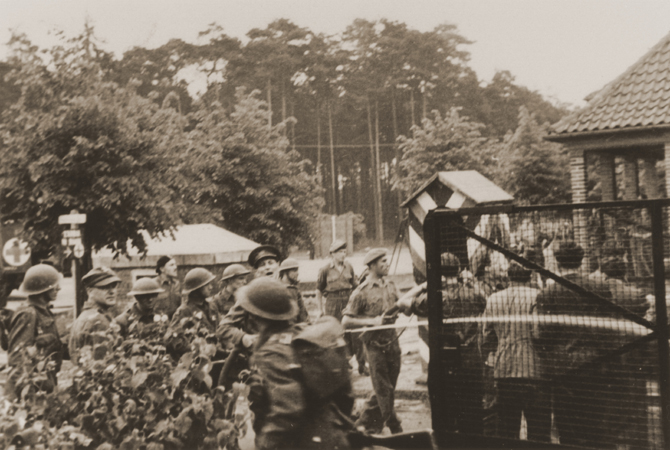 British soldiers at the liberation of Bergen-Belsen Source: USHMM.
British soldiers at the liberation of Bergen-Belsen Source: USHMM.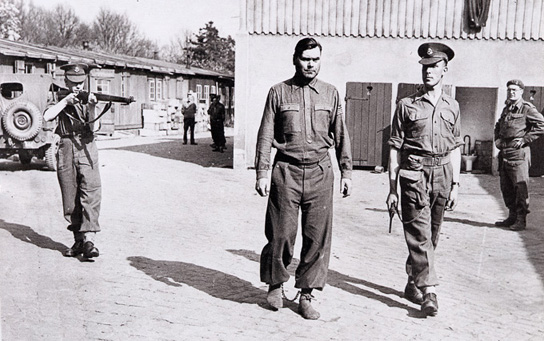 Camp commander Kramer is arrested by the British. Source: Scrapbookpages.
Camp commander Kramer is arrested by the British. Source: Scrapbookpages.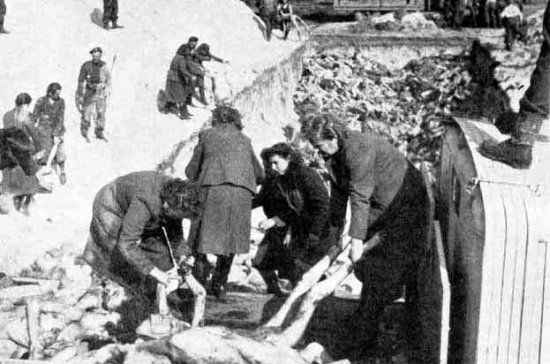 The SS-men who did not fled, were deployed to bury the many bodies. Source: Scrapbookpages.
The SS-men who did not fled, were deployed to bury the many bodies. Source: Scrapbookpages.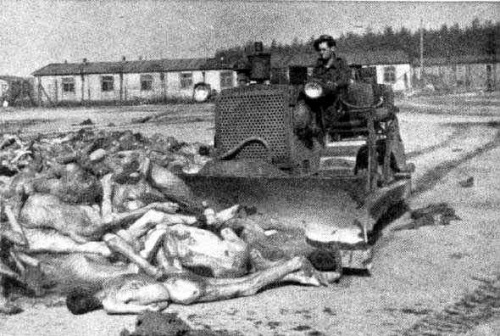 Because burying the bodies by hand took too long, the British eventually deployed this bulldozer. Source: Scrapbookpages.
Because burying the bodies by hand took too long, the British eventually deployed this bulldozer. Source: Scrapbookpages.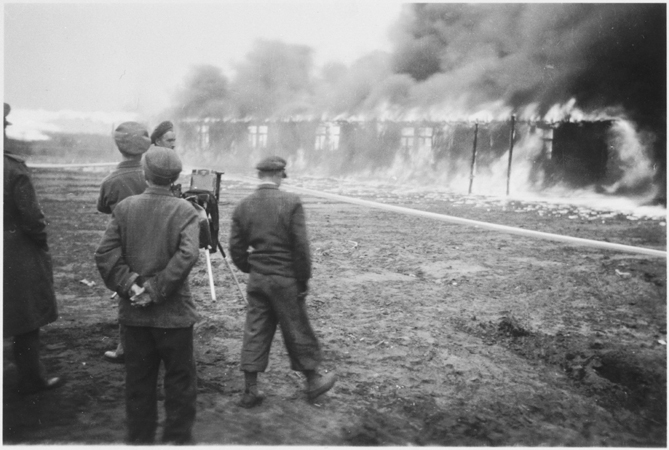 In the end, the barracks were set on fire to prevent the typhoid epidemic from spreading. Source: Scrapbookpages.
In the end, the barracks were set on fire to prevent the typhoid epidemic from spreading. Source: Scrapbookpages.Monument Bergen-Belsen
On 25 September 1945, following a congress of liberated Jews in the British occupation zone, a provisional wooden commemoration cross was placed between the mass graves. On 15 April 1946, the Belsener Jüdische Komitee revealed a stone commemoration monument with Hebrew and English inscription: a large square stone with Jewish symbols on a triangular base. This monument is the centre of Jewish commemorative ceremonies each year. The English inscription reads:
Israel and the world shall rememberThirty thousand Jews
Exterminated in the Concentration Camp
Of Bergen-Belsen
At the hands of the murderous Nazis
Earth conceal not the blood
Shed on thee!
First anniversary of liberation
15th April 1946
/14th Nissan 5706/
Central Jewish Committee
British Zone
The British military government ordered the erection of a large, worthy monument in October 1945. Early 1947, the build of the central monument started – a 24 metre high obelisk and a 50 metre long wall with inscriptions. Each country which mourned the loss of victims in Bergen-Belsen received a spot on the wall to place a text. For the Netherlands, the text below was used:
HET ZWAARST GESCHUT EN 'T BEST GEWEERKAN OP HET SLAGVELD VOORDEEL GEVEN,
HIER HIELP GEEN KRACHT VAN WAPENS MEER
GEEN STRIJD, HIER LEED EEN VOLK VOOR'T LEVEN.
In 1952, Lower Saxony was given the responsibility of taking care of the Bergen-Belsen monument (Gedenkstätte), while on 30 November of that same year, the official inauguration of the Mahnmal took place. In total 14 mass graves are located on the site of the former concentration camp. Each mass grave has a memorial stone with the number of dead. Spread across the site, a number of single graves and memorial stones can be found, for instance for Anne Frank. The last mass grave was constructed in 1964, when bones and ashes were discovered in the former crematorium. Not all victims of Bergen-Belsen are buried at the site of the Gedenkstätte. Numerous victims were buried at the Großen Friedhof für die Opfer der nationalsozialistischen Gewaltherrschaft in Bergen-Hohne. As of 1987, the Kriegsgräberstätte Hörsten, where a monument for the thousands of Soviet victims was erected, is also part of the Gedenkstätte Bergen-Belsen.
In 1966, the first small documentation centre was opened, that was replaced by a bigger centre in 1990. The new documentation centre included, amongst others, a library and archive. Information can be found on the history of Bergen-Belsen. A special exhibit focuses on the National Socialist system of prosecution.
As of 1991 several youth organisations from Lower Saxony started with a kind of renovation project. During project weeks and work camps they try to excavate the foundations of the former concentration camp. The YMCA is still undertaking these excavation works.
Definitielijst
- Concentration Camp
- Closed camp where people are being held captive that are considered to be anti- social, enemies of the state, criminal or unwanted individuals. These groups mostly do not get a fair trial or are condemned to doing time in a camp.
- Jews
- Middle Eastern people with own religion that lived in Palestine. They distinguished themselves by their strong monotheism and the strict observance of the Law and tradition. During World War 2 the Jewish people were ruthlessly persecuted and annihilated by the German Nazis. . An estimated 6,000,000 Jews were exterminated.
Images
Information
- Article by:
- Gerd Van der Auwera
- Translated by:
- STIWOT translator
- Published on:
- 11-02-2016
- Last edit on:
- 02-05-2020
- Feedback?
- Send it!
Related sights
Related books
Sources
- ECK, L. VAN, Het boek der kampen, Kritak, Leuven, 1978.
- HERZBERG, A.J., Tweestromenland, Amsterdam, Querido, 1978.
- KNOPP, G., Hitlers Holocaust, Byblos, Amsterdam, 2001.
- REES, L., Auschwitz, Anthos, Amsterdam, 2005.
- Bergen-Belsen 1943-1945. In '40 – '45 Toen en nu. S.a, Soest.
- www.bergen-belsen.de
- Bergen-Belsen
- www.dhm.de
